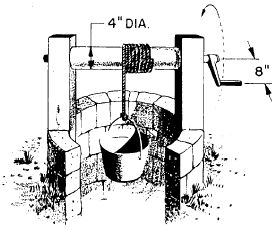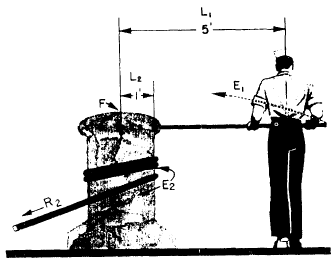|
MOMENT OF FORCE
In several situations you can use the wheel-and-axle to speed up
motion. The rear-wheel sprocket of a bike, along with the rear wheel
itself, is an example. When you are pedaling, the sprocket is attached
to the wheel; so the combination is a true wheel-and-axle machine.
Assume that the sprocket has a circumference of 8 inches, and the wheel
circumference is 80 inches. If you turn the sprocket at a rate of one
revolution per second, each sprocket tooth moves at a speed of 8 inches
per

Figure 3-2.-The old oaken bucket.
second. Since the wheel makes one revolution for each revolution made
by the sprocket, any point on the tire must move through a distance of
80 inches in 1 second. So, for every 8-inch movement of a point on the
sprocket, you have moved a corresponding point on the wheel through 80
inches.
Since a complete revolution of the sprocket and wheel requires only 1
second, the speed of a point on the circumference of the wheel is 80
inches per second, or 10 times the speed of a tooth on the sprocket.
(NOTE: Both
sprocket and wheel make the same number of revolutions per second, so
the speed of turning for the two is the same.)
Here is an idea that you will find useful in under-standing the wheel
and axle, as well as other machines. You probably have noticed that the
force you apply to a lever starts to turn or rotate it about the
fulcrum. You also know that a sheave on a fall starts to rotate the
sheave of the block. Also when you turn the steering wheel of a car, it
starts to rotate the steering column. Whenever you use a lever, or a
wheel and axle, your effort on the lever arm or the rim of the wheel
causes it to rotate about the fulcrum or the axle in one direction or
another. If the rotation occurs in the same direction as the hands of a
clock, we call that direction clockwise. If the rotation occurs in the
opposite direction from that of the hands of a clock, we call that
direction of rotation counterclockwise. A glance at figure 3-3 will make
clear the meaning of these terms.
The force acting on the handle of a carpenters brace depends not only
on the amount of that force, but also on the distance from the handle to
the center of rotation. This is known as a moment of force, or a torque
(pronounced tork). Moment of force and torque have the same meaning.
Look at the effect of the counterclockwise movement of the capstan bar
in figure 3-4. Here the amount of the effort is designated El and the
distance from the point where you apply the force to the center

Figure 3-3.-Directions of rotation.

Figure 3-4.-Using the capstan.
of the axle is L1. Then,
E1 x L1
is the moment of force. Youll notice that this term includes both the
amount of the effort and the distance from the point of application of
effort to the center of the axle. Ordinarily, you measure the distance
in feet and the applied force in pounds.
Therefore, you measure moments of force in foot-pounds (ft-lb). A
moment of force is frequently called a moment.
By using a longer capstan bar, the sailor in figure 3-4 can increase
the effectiveness of his push without making a bigger effort. If he
applied his effort closer to the head of the capstan and used the same
force, the moment of force would be less.
|

